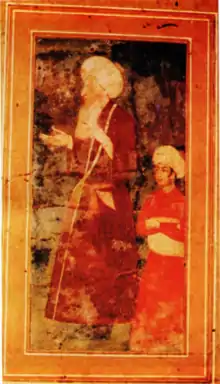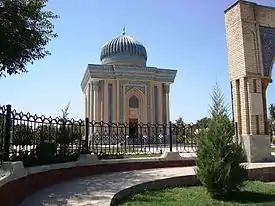Khwaja Ahrar
Nassiruddin Ubaidullah Ahrar (1404-1490 AD) more popularly known as Khwaja Ahrar was a Hanafi Maturidi[1] member of the Golden Chain of the Naqshbandi Sufi spiritual order of Central Asia. He was born in Samarkand, Uzbekistan[2] to a religious and devout muslim family. He was born to Khwaja Mehmood Shashi bin Khwaja Shihabuddin. His forefathers had migrated from Baghdad and his lineage connected to Abu Bakr Siddique from his paternal side and Umar Farooq from the maternal side.[3][4] Khwaja Ahrar was deeply involved in the social, political and economics activities of Transaxonia. He was a born into a relatively poor yet highly spiritual family and at the age of maturity he was probably the richest person in the kingdom.[5] He was a close associate of all the leading dervishes of the time. Maulana Abdur Rahman Jami was a disciple of his.[6][7] He learned and practiced the secrets of spirituality under his father and later under Khwaja Yaqub Charkhi.[8]

Birth and Family
Khwaja's father was a farmer by profession and had also performed pilgrimage to Makkah. His paternal grandfather, Shahabuddin Shashi was also a farmer and trader. His maternal grandfather Khwaja Daud was the son of Khwaja Khawand Tahur who was a established sufi mystic and the son of Umar Baghistani, a famous shaikh who was honoured by Bahauddin Naqshband.[9] His birth took place during the ramadan of 806 Hijri (March, 1404) in village near Tashkent called Baghistan.[10] His birth was accompanied by a number of miracles and many saints had predicted the coming of a saint.[11]
He has two sons, Khwaja Khwajgan and Khwaja Yahya.[12]
Education and Learning
Initially, Ahrar studied in Tashkent,[13] his uncle, Ibrahim Shashi also used to teach him. In 1425, his uncle took him to Samarqand for his studies. Repetitively fallen sick during studies made him quit altogether but his spiritual states developed until once he saw prophet Jesus in his dream where he said "I will teach you." He interpreted this to mean he would receive religious knowledge however other disagreed and said it meant medicical knowledge.
Life
After returning from Herat at the age of 29 he had completed his training. He bought a piece of cultivable land and began farming. His land produced a great deal of yield and he was able to grow very fast. Within the period of a decade he owned many farming lands, businesses, turkish baths, khanqahs and was sending trading caravans well into China.[14] Historians contend he had become one of the richest men of Central Asia.[15] He used to spend most of his money on the needy. Most of his wealth was invested in Waqf (religious endowments) and was used for the needy.[16]
Political Life
A Timurid prince, was the sultan of Samarqand at the time. Khwaja Ahrar went to meet him in order to discuss the condition of the people. However the chief aid of the sultan displayed no interest at which Khwaja Ahrar told him "I have been commanded by God and His messenger to come here". The sultan's aid still did not show any sign of talking and said the sultan is not concerned about the people. At this the Khwaja wrote the name of the Sultan on the wall and having erased it with his saliva said "God will replace you with a King who is concerned for his people" and left. Some days later as history records, Sultan Abu Sa'id Mirza, another Timurid King gathered his forces an attacked Samarqand. Sultan Abu Saeed later became the grandfather of Zahiruddin Muhammad Babur, the conqueror of India and creator of the Mughal Empire. This union of the Abu Sa'id Mirza and Khwaja Ahrar was to prove decades long and fruitful for the whole kingdom.[17]
Khwaja Ahrar also named Babur in his infancy as Zahiruddin Muhammad literally 'Defender of Religion'.
The height of Khwaja Ahrar's career coincided with the cultural efflorescence of Herat[18] during the reign of Sultan Husayn Bayqara. Many of his enemies accused him of amassing huge amount of wealth.[19] However, he always spent his wealth for the poor. Regardless he became a very rich man owning more 3500 acres of cultivable land at one time. He had many properties,[20] including mosques[21] and madrassas that were waqf.[22]
Spiritual Life
Khwaja Ahrar took his spiritual bayah (spiritual oath) from Yaqub al-Charkhi Shaikh Yaqub Charkhi.[23][24] He had many disciple but the most famous was the famous sufi poet Mawlana Abdur Rahman Jami. Maulana Jami wrote a book dedicated to Ahrar which is called Tuhfa tul Ahrar and Khwaja Ahrar is also mention in Jami's most famous work Yusuf and Zulekha.[25] Khwaja Ahrar is also known to have negotiated peace many times.[26] His spiritual disciples are recorded to have shown extremely high etiquettes and morals in his presence.[27]
Famous Quotes
"Everyone enters through a different door; I entered this Spiritual Order through the door of service."[28]
"Love and follow Lovers. Then you will be like them and their love will reflect on you."[29]
"Sufism requires you to carry everyone’s burdens and not to put yours on anyone."[30]

Death
Khwaja Ahrar passed away when he was 89 years old, Samarqand, in 896 Hijri. His chronogram is خلدِ برین which was discovered by Ali Shernawai.[31] He left a huge fortune and his family continued his preachings.
References
- Nishapuri, Mir Abd al-Avval (2002). Malfuzat Ahrar. Markaz-i Našr-i Dānišgāhī. p. 208.
- 1533., Ṣafī, ʻAlī ibn Ḥusayn Kāshifī, 1463-1532 or (2001). Beads of dew : from the source of life : histories of the Khwājagān, the masters of wisdom = Rashaḥāt 'ain al-ḥayāt. Al-Baz Publishing. p. 245. ISBN 1882216210. OCLC 70661671.CS1 maint: numeric names: authors list (link)
- Masatomo., Mawlānā Šayḫ. Kawamoto (2004). Maqāmāt-i Ḫwāǧa Aḥrār : tad̲kira-i Ḫwāǧa Nāṣir ad-Dīn ʻUbaydallāh Aḥrār (806 tā 895 q). Muʼassasa-i Muṭālaʻāt-i Zabānhā wa Farhanghā-i Āsiyā wa Āfrīqā. p. 21. ISBN 4872978986. OCLC 727987567.
- Safi, Mawlana Ali ibn Husain (2001). Rashahat Ain al-Hayat. Translated by Holland, Muhtar. Al Baz.
- Algar, H. (2004-05-01). "Review: The Letters of Khwaja 'Ubayd Allah Ahrar and his Associates * Jo-Ann Gross, Asom Urunbaev: The Letters of Khwaja 'Ubayd Allah Ahrar and his Associates". Journal of Islamic Studies. 15 (2): 225. doi:10.1093/jis/15.2.224. ISSN 0955-2340.
- "THE DEVELOPMENT OF THE NAQSHBAND". www.allamaiqbal.com. Retrieved 2019-02-11.
- "Aḥrār, Khvāja ʿUbaydallāh". doi:10.1163/1573-3912_ei3_com_23939. Cite journal requires
|journal=(help) - 1533., Ṣafī, ʻAlī ibn Ḥusayn Kāshifī, 1463-1532 or (2001). Beads of dew : from the source of life : histories of the Khwājagān, the masters of wisdom = Rashaḥāt 'ain al-ḥayāt. Al-Baz Publishing. p. 250. ISBN 1882216210. OCLC 70661671.CS1 maint: numeric names: authors list (link)
- 1533., Ṣafī, ʻAlī ibn Ḥusayn Kāshifī, 1463-1532 or (2001). Beads of dew : from the source of life : histories of the Khwājagān, the masters of wisdom = Rashaḥāt 'ain al-ḥayāt. Al-Baz Publishing. ISBN 1882216210. OCLC 70661671.CS1 maint: numeric names: authors list (link)
- صفی, مولانا. رسحات رعین الحیات.
- 1533., Ṣafī, ʻAlī ibn Ḥusayn Kāshifī, 1463-1532 or (2001). Beads of dew : from the source of life : histories of the Khwājagān, the masters of wisdom = Rashaḥāt 'ain al-ḥayāt. Al-Baz Publishing. p. 245. ISBN 1882216210. OCLC 70661671.CS1 maint: numeric names: authors list (link)
- Masatomo., Mawlānā Šayḫ. Kawamoto (2004). Maqāmāt-i Ḫwāǧa Aḥrār : tad̲kira-i Ḫwāǧa Nāṣir ad-Dīn ʻUbaydallāh Aḥrār (806 tā 895 q). Muʼassasa-i Muṭālaʻāt-i Zabānhā wa Farhanghā-i Āsiyā wa Āfrīqā. ISBN 4872978986. OCLC 727987567.
- Paul, Jürgen (November 1991). "Forming a Faction: The imāyat System of Khwaja Ahrar". International Journal of Middle East Studies. 23 (4): 533–548. doi:10.1017/s0020743800023400. ISSN 0020-7438.
- Ed., Gross, Jo-Ann, (1949- ...). (1994). Muslims in Central Asia expressions of identity and change. Duke University Press. ISBN 0822311879. OCLC 489867227.
- Gross, Jo‐Ann (January 1988). "The economic status of a Timurid Sufi Shaykh: a matter of conflict or perception?". Iranian Studies. 21 (1–2): 85. doi:10.1080/00210868808701710. ISSN 0021-0862.
- "NITLE Arab World Project". acc.teachmideast.org. Retrieved 2019-02-11.
- ١٤٠٤-١٤٩٠م., احرار، عبيد الله بن محمود، (2002). The letters of Khwāja ʻUbayd Allāh Aḥrār and his associates. Brill. p. 14. ISBN 9004126031. OCLC 49312673.
- Manz, Beatrice Forbes (2007-03-01). Power, Politics and Religion in Timurid Iran. Cambridge University Press. ISBN 9781139462846.
- Gross, Jo‐Ann (January 1988). "The economic status of a Timurid Sufi Shaykh: a matter of conflict or perception?". Iranian Studies. 21 (1–2): 84–104. doi:10.1080/00210868808701710. ISSN 0021-0862.
- Malik, Jamal (1995-01-01). "Marc Gaborieau / Alexandre Popovic / Thierry Zarcone (eds.): Naqshbandis; Historical Developments and Present Situation of a Muslim Mystical Order. Istanbul: Institut Français d'Études Anatoliennes, 1990". Die Welt des Islams. 35 (1): 145–147. doi:10.1163/1570060952597914. ISSN 0043-2539.
- Afsaruddin, Asma (2001). "Windows on the House of Islam: Muslim Sources on Spirituality and Religious Life, edited by John Renard. 439 pages, maps, notes, appendices, index. Berkeley, CA: University of California Press, 1998. $22.00 (Paper) ISBN 0-520-21086-7". Middle East Studies Association Bulletin. 35 (1): 71. doi:10.1017/s0026318400041602. ISSN 0026-3184.
- Dahnhardt, T. (2001-05-01). "Naqshbandis in Western and Central Asia: Change and Continuity Edited by Elisabeth Ozdalga. Richmond: Curzon Press, 1999. Pp. 187. Price PB 16.00. 0-7007-1147-3". Journal of Islamic Studies. 12 (2): 195–197. doi:10.1093/jis/12.2.195. ISSN 0955-2340.
- Gross, Jo-Ann (2015-01-01). "Aḥrār, Khvāja ʿUbaydallāh". Encyclopaedia of Islam, THREE.
- 1533., Ṣafī, ʻAlī ibn Ḥusayn Kāshifī, 1463-1532 or (2001). Beads of dew : from the source of life : histories of the Khwājagān, the masters of wisdom = Rashaḥāt 'ain al-ḥayāt. Al-Baz Publishing. p. 248. ISBN 1882216210. OCLC 70661671.CS1 maint: numeric names: authors list (link)
- Shadchehr, Farah Fatima Golparvaran (2008). "ABD AL-RAHMAN JAMI: "NAQSHBANDI SUFI, PERSIAN POET". Ohio University: 3. Cite journal requires
|journal=(help) - Algar, H. (2004-05-01). "Review: The Letters of Khwaja 'Ubayd Allah Ahrar and his Associates * Jo-Ann Gross, Asom Urunbaev: The Letters of Khwaja 'Ubayd Allah Ahrar and his Associates". Journal of Islamic Studies. 15 (2): 224–226. doi:10.1093/jis/15.2.224. ISSN 0955-2340.
- Avery, Peter (June 1993). "Leonard Lewisohn (ed.): The legacy of mediaeval Persian Sufism. xiv, 434 pp. London and New York: Khaniqahi Nimatullahi Publications, 1992". Bulletin of the School of Oriental and African Studies. 56 (2): 250. doi:10.1017/s0041977x00005826. ISSN 0041-977X.
- "Ubaydullah al-Ahrar, qaddasa-l-Lahu sirrah | The Naqshbandi Haqqani Sufi Order of America: Sufism and Spirituality". naqshbandi.org. Retrieved 2018-12-08.
- "Ubaydullah al-Ahrar, qaddasa-l-Lahu sirrah | The Naqshbandi Haqqani Sufi Order of America: Sufism and Spirituality". naqshbandi.org. Retrieved 2018-12-08.
- "Ubaydullah al-Ahrar, qaddasa-l-Lahu sirrah | The Naqshbandi Haqqani Sufi Order of America: Sufism and Spirituality". naqshbandi.org. Retrieved 2018-12-08.
- نوشاہی, عارف. خواجہ احرار. Islamabad: Poorab Academy.
